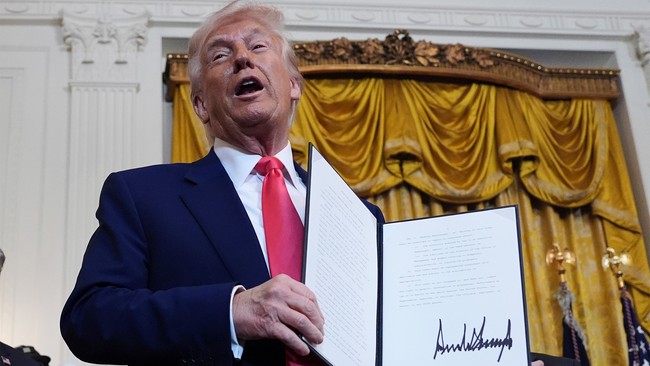
Yesterday, President Trump signed an executive order titled “Restoring Equality of Opportunity and Meritocracy.” The basic point of this is to undermine what is known as disparate-impact theory. Here’s how the executive order describes it.
A bedrock principle of the United States is that all citizens are treated equally under the law. This principle guarantees equality of opportunity, not equal outcomes. It promises that people are treated as individuals, not components of a particular race or group. It encourages meritocracy and a colorblind society, not race- or sex-based favoritism. Adherence to this principle is essential to creating opportunity, encouraging achievement, and sustaining the American Dream.
But a pernicious movement endangers this foundational principle, seeking to transform America’s promise of equal opportunity into a divisive pursuit of results preordained by irrelevant immutable characteristics, regardless of individual strengths, effort, or achievement. A key tool of this movement is disparate-impact liability, which holds that a near insurmountable presumption of unlawful discrimination exists where there are any differences in outcomes in certain circumstances among different races, sexes, or similar groups, even if there is no facially discriminatory policy or practice or discriminatory intent involved, and even if everyone has an equal opportunity to succeed. Disparate-impact liability all but requires individuals and businesses to consider race and engage in racial balancing to avoid potentially crippling legal liability. It not only undermines our national values, but also runs contrary to equal protection under the law and, therefore, violates our Constitution.
The order then requires several actions which are summarized in an accompanying fact sheet published by the White House.
- The Order revokes presidential actions that approved of disparate-impact liability and sets in motion broader reform.
- It directs all agencies to deprioritize enforcement of statutes and regulations that include disparate-impact liability.
- The Order instructs the Attorney General to repeal or amend all Title VI (racial nondiscrimination) regulations that contemplate disparate-impact liability.
- It directs the administration to assess all pending investigations, lawsuits, and consent judgements that rely on a theory of disparate-impact liability, and take appropriate action.
This is, to put it mildly, a big deal. City Journal’s Heather Mac Donald argues it’s the “most important step” to restore meritocracy in America.
Measured in Trump time, it took them eons to get around to it, but the White House has finally taken the most important step it can to restore meritocracy to American society: eliminating disparate-impact theory from civil rights analysis and enforcement.
Disparate-impact theory holds that if a neutral, colorblind standard of achievement or behavior has a disproportionately negative effect on underrepresented minorities (overwhelmingly, on blacks), it violates civil rights laws. It has been used to invalidate literacy and numeracy standards for police officers and firemen, cognitive skills and basic knowledge tests for teachers, the use of SATs in college admissions, the use of grades for medical licensing exams, credit-based mortgage lending, the ability to discipline insubordinate students, and criminal background checks for employees and renters. It has been used to eliminate prosecution for a large range of crimes, including shoplifting, turnstile jumping, and resisting arrest; to end police tactics such as proactive stops (otherwise known as stop, question, and frisk); and to purge safety technologies like ShotSpotter and speeding cameras from police departments.
In none of those cases has it ever been demonstrated that the disfavored standard was implemented to exclude blacks or other minorities from a position, opportunity, or right. The genius (if a diabolical one) of disparate-impact theory was that it obviated any need to show discriminatory intent on the part of a targeted employer or institution. Discrimination was inferred simply by the effect of the colorblind standard.
Naturally, the left sees this very differently.
This represents a fundamental shift in legal philosophy. For decades, disparate impact theory has enabled agencies to investigate and remedy policies that, while race-neutral on their face, produce discriminatory outcomes—whether in employment, housing, education, environmental regulation, or access to credit. It reflects the reality that racism in America often functions structurally, not just individually. By contrast, Trump’s executive order embraces a formalist, colorblind conception of equality that ignores context, history, and outcome…
Historically, disparate impact has been indispensable in cases where intent was difficult or impossible to prove. In Griggs v. Duke Power Co. (1971), for example, the Supreme Court held that an employer’s requirement of a high school diploma—while not explicitly racist—disproportionately excluded Black applicants and was not related to job performance. This ruling opened a path to address indirect forms of discrimination that were—and still are—pervasive.
By reversing course, Trump’s order pushes civil rights enforcement back to a pre-Griggs era. It narrows the definition of discrimination so dramatically that entire categories of inequality—redlining, biased algorithms, exclusionary zoning—could become legally invisible, simply because they don’t come with explicit racist intent.
But Mac Donald essentially argues the 1971 case was in error and that Trump is restoring a pre-1971 understanding of the Civil Rights Act.
…it was disparate-impact theory itself that constituted a radical departure from the premises of the Civil Rights Act of 1964. President Donald Trump merely restores the 1964 law to its original understanding. That pioneering legislation banned intentional discrimination only; disparate-impact theory was a judicial amendment made six years later in response to how, even in 1971, finding invidious intentional discrimination was becoming too difficult to satisfy the advocates.
She wraps up by noting that anything Trump can change by executive order can be changed back just as easily by a future occupant of the White House. In order for this change to last, she urges “Congress to clarify that civil rights mean freedom from discrimination—not the legitimization of ‘reverse discrimination.'”
No doubt we’ll all be hearing a lot more about disparate-impact theory over the coming weeks. Right now the left is too focused on returning an illegal alien gang member to the US to focus on this but they’ll get around to it soon enough.






